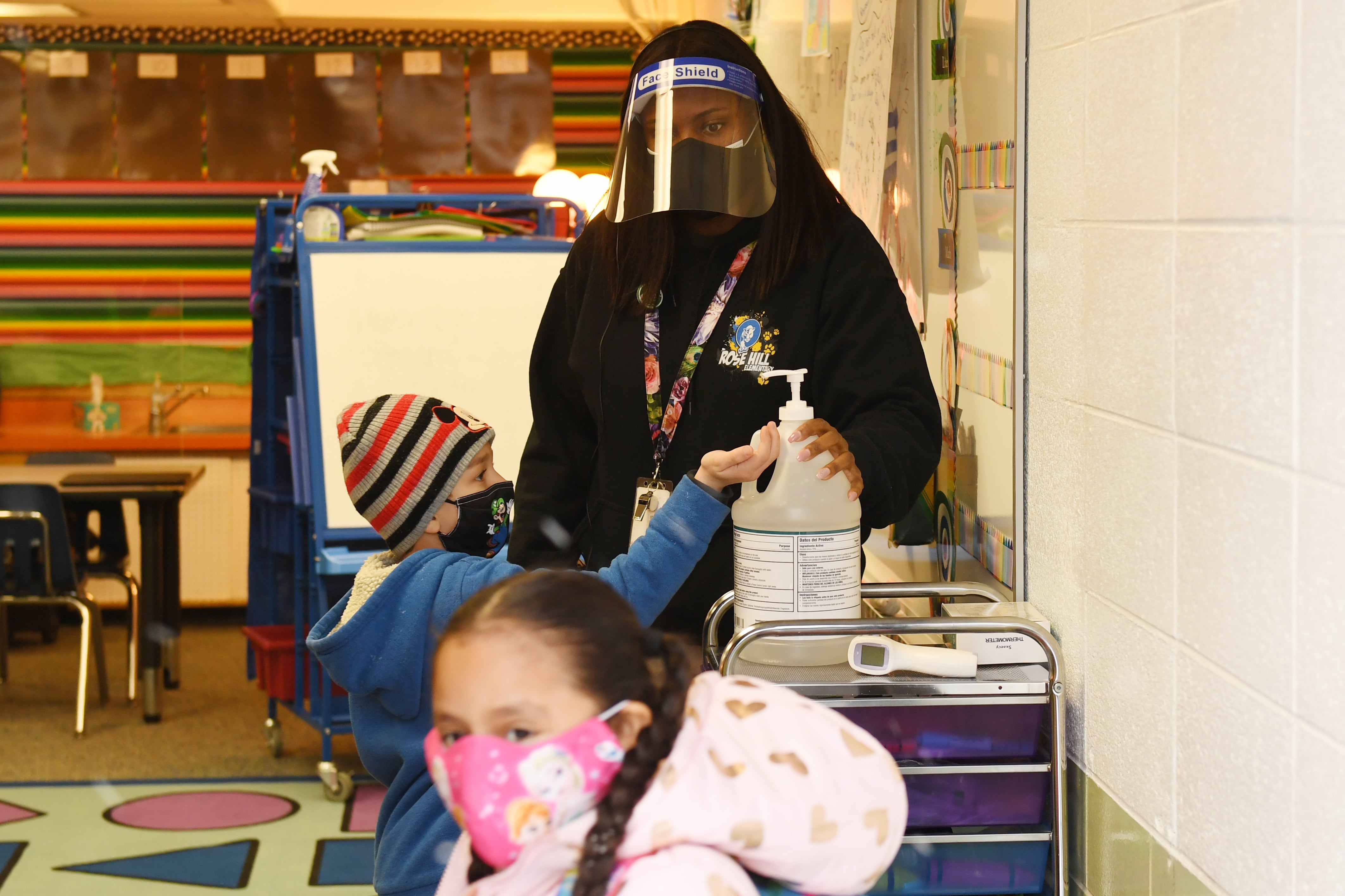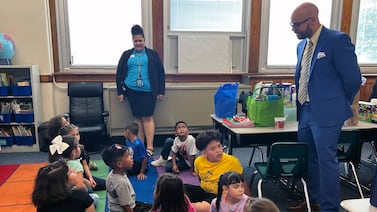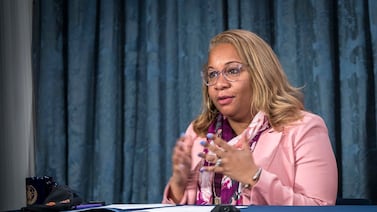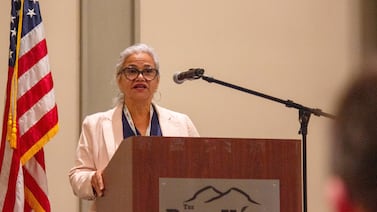Elementary students in Adams 14 schools went back to classrooms in person Monday for the first time since March, but despite much anticipation, fewer than half of students showed up in school buildings.
Merida Sifuentes, mother of a 9-year-old fourth grader who did go back, said it was a difficult choice.
Her husband recently had a kidney transplant, and she’s pregnant, so both are potentially at high risk of serious illness from the coronavirus. But ultimately, she said, it came down to her son’s need for interaction and more rigor.
“I do feel like he was learning, but I just think his potential wasn’t to where it could be,” Sifuentes said.
And the first day went well.
“He was very happy,” Sifuentes said. ”He’s made friends in virtual learning so for him to see some of those friends, he was so excited.”
In Adams 14, many families have no internet and many are at high risk of hospitalization or death from COVID. On top of that, the district still faces a deadline to improve its academic performance, so leaders have faced a particularly challenging decision to reopen school buildings.
Taking ‘every precaution’
The small district is one of few in Colorado that never reopened its schools in the fall. Superintendent Don Rangel pleaded with the school board in December to give his team a chance. The district was prepared for students and had taken every precaution, he said.
Adams 14 purchased water bottles for every student so that they won’t have to use water fountains. The district put shields around desks, purchased masks and thermometers, and rolled out an application where families and school staff input health data every day when they screen students before class.
Board members, including two who lost family members to COVID last year, struggled with the decision but ultimately decided that if cases go down, students should have the option.
“I think overall the best thing for kids is to be in school, if we can possibly do that,” said board President Ramona Lewis. “It’s been difficult — a lot of sleepless nights weighing all of the different people’s opinions and trying to make the decision for Commerce City, not for anybody else.”
Four of the five members on the Adams 14 school board are new and had just started getting used to their board work. That includes one member who was appointed in February, just a month before schools shut down because of COVID-19.
Lewis said that although she’s new to the board, she’s worked with school boards for about 25 years, and still wasn’t prepared.
“I never thought that I would have to make these kinds of decisions,” she said. “Other than school closures, these are the hardest decisions that board members have to make.”
In Colorado, because of local control, every school district has had to weigh for itself whether it’s safe to return to school buildings. State and local public health experts have provided guidance and recommendations, but district leaders at times have said that it hasn’t been enough.
Unique circumstances
In Commerce City-based Adams 14, community members have lots to say about the district’s unique circumstances.
The community is surrounded by industrial plants and warehouses, highways, the former Rocky Mountain Arsenal which is now a wildlife refuge, and an oil refinery about a mile from one district school. All of those contribute to pollution and affect residents’ health. People living in Adams County, and Commerce City in particular, have higher rates of asthma and diabetes than in other metro area counties. Both of those conditions put people at higher risk of a serious case of COVID.
“We have a lot of positives in Commerce City, but we also have some things that totally work against us,” said board member Maria Zubia. “When you talk about our buildings and our schools, that was the first thing that kept coming to my mind.”
But she and other officials also worried about the challenges families have had with remote learning.
One challenge has been with connecting families to the internet.
In Commerce City, census numbers estimate that in 2019 more than 15% of households didn’t have internet, higher than statewide percentages. The estimate is that those households include nearly 1,800 children.
The district has paid for more than 700 modems that it has given to families. This month, the district is asking families to come in to exchange those modems for a T-Mobile hotspot. The district is changing contracts, in part, looking to get a stronger signal.
Deborah Figueroa, a middle school teacher and co-president of the teacher’s union, said she wasn’t surprised that less than half of students will attend in person.
One factor, she said, is that many Adams 14 parents are essential workers who don’t have paid sick time and would struggle to quickly change child care arrangements if students suddenly had to go on quarantine.
“They’re watching the news and they see the neighboring schools that are opening, closing, and then quarantines,” Figueroa said. “They can’t afford that.”
Many teachers hesitant
As elsewhere, Figueroa said many teachers in Adams 14 hesitate to go back to in-person learning. After one district training to prepare staff last week, a union survey showed only 30% of those staff members felt ready.
The union sent a last-minute request to the district last week asking for another delay to reopening.
“The fear might not go away but we wanted people to feel prepared,” Figueroa said.
One part of the feeling of being unprepared, she said, had to do with some last-minute adjustments.
Fall surveys, including a last one in October, led the district to prepare for only 30% of students continuing remote learning. But then in a survey that closed this month more than 51% indicated they would stay remote.
The district had already selected teachers for the remote model. But then, after the January numbers, building principals asked more teachers to stay online. In buildings where more teachers volunteered than were needed, there was some confusion over who had priority.
Over the weekend, Figueroa said, many teachers had to adjust their lesson plans to new class rosters or teaching formats.
Teachers and other board members believe socioeconomic and cultural factors also make the district’s community more likely to choose to stay remote. Many students live in multi-generational homes with grandparents, and others live in homes with two or three families who split the rent.
Elizabeth Vitela, a mother of four children, said she is planning to keep her 14-year-old son, a freshman at Adams City High School, home.
Vitela said that despite her family’s precautions, all of her family got COVID in the fall. None exhibited serious symptoms, and now she’s less concerned.
“We know this pandemic is going to continue for some time,” Vitela said. “More than anything we saw that he was doing better and was more focused than when he was in person.”
Gauging safety
The district plans for middle and high school students to return to a hybrid version of in-person learning over the next two weeks.
District officials are now gauging safety based on the two-week incidence rates of COVID. For months, Adams County has had some of the highest case rates in the Denver metro area. A study in Denver found that Hispanic people were more likely to live in overcrowded housing, more likely to keep working when sick due to lack of paid leave, and more likely to delay testing, all conditions that also exist in Adams County and that likely have contributed to higher case rates.
After planning to bring elementary students back last week, the district delayed reopening by a week because of high incidence rates.
Now, with lower rates as of Tuesday — about 514 per 100,000 people — the district’s remaining concern is about having enough substitute teachers for classrooms if teachers become sick or have to go on quarantine.
Earlier this month, district officials told the board they had 24 substitutes committed to fill in-person absences.
Despite acknowledging factors that put the community at high risk, board members still want to see people putting in more effort to slow the spread which in turn may avoid school transmission and the need for frequent quarantines.
“I’ve been really disappointed,” said board member Renee Lovato. “I don’t know that anyone has figured out how to get this message to reach a primarily Spanish-speaking population.”
But district officials are optimistic. Monday and Tuesday have gone well, leaders said.
“We felt that it was a success,” said Shelagh Burke, the district’s chief academic officer. “The energy was positive in the buildings. Students were excited to return.”






